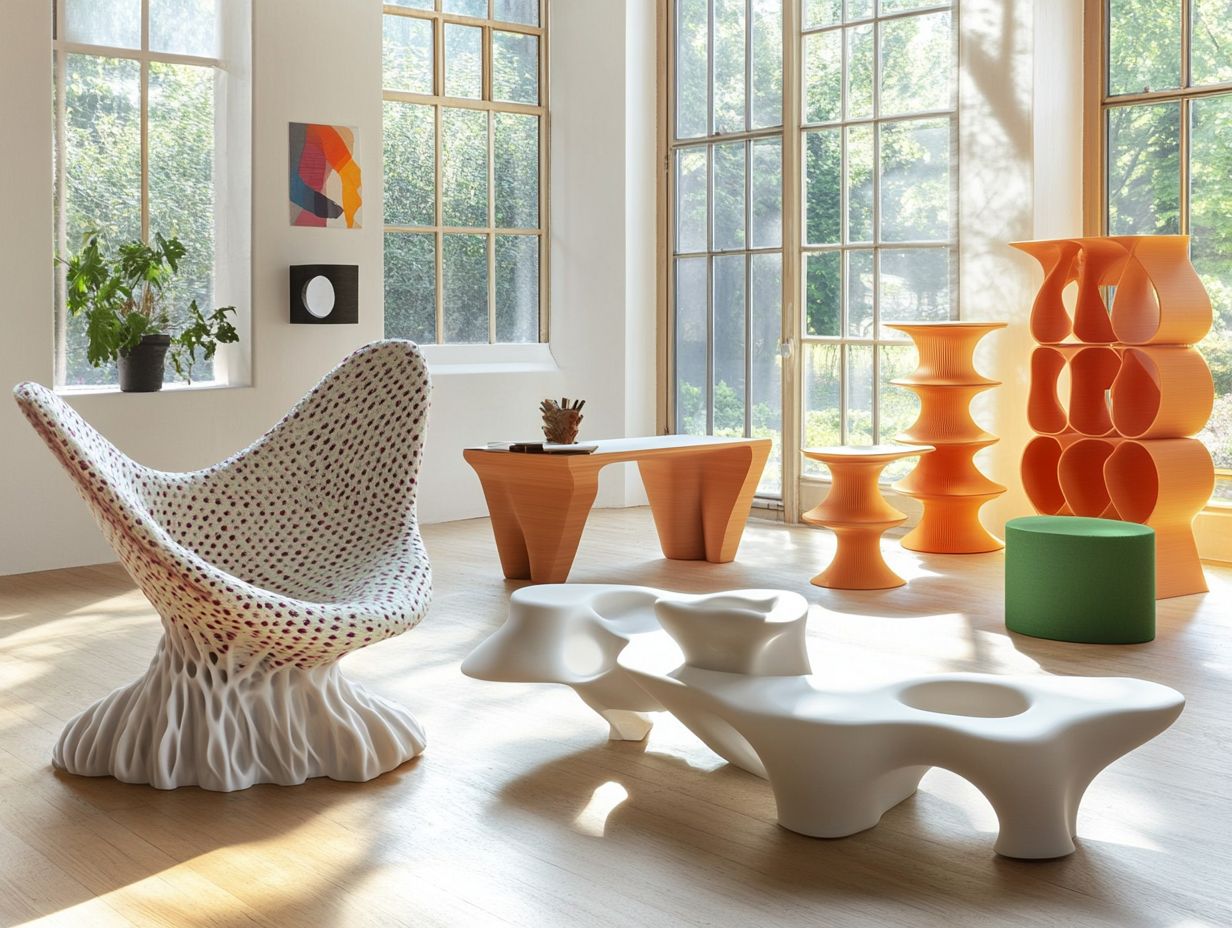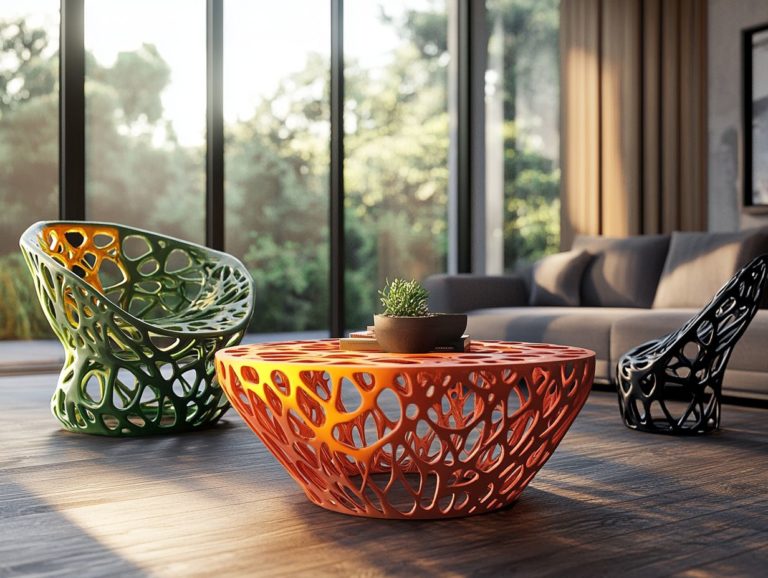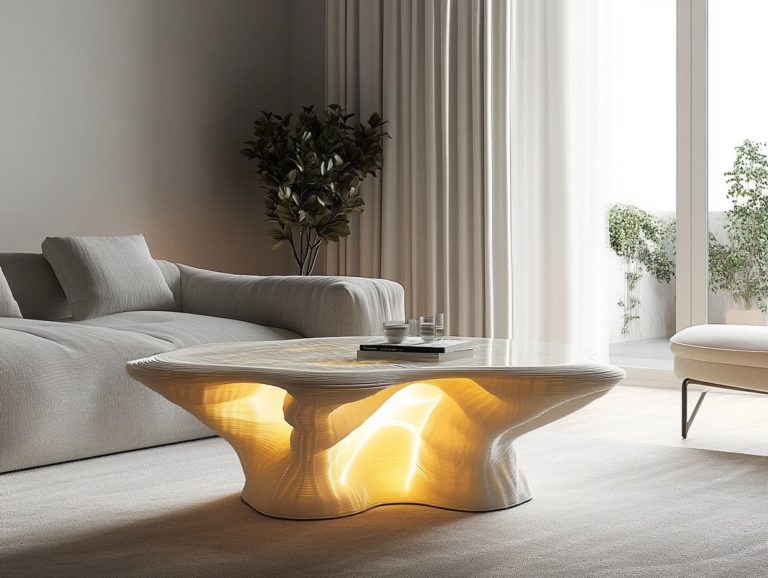3D-Printed Furniture: Customization Options Explained
3D printing is revolutionizing the furniture industry, bringing new ways to customize and innovate.
Imagine selecting from a myriad of unique designs and materials, crafting personalized features that perfectly align with your specific needs and aesthetic preferences. This technology empowers you to tailor furniture in a way that truly reflects your individuality.
3D-printed furniture offers impressive benefits, including enhanced efficiency, cost savings, and a minimized environmental footprint. However, it also faces challenges like technological limitations and regulatory hurdles.
Explore how 3D-printed furniture is reshaping design and promoting sustainability today!
Contents
Key Takeaways:

- 3D printing offers endless design and material choices, allowing you to create furniture that reflects your style.
- Enjoy efficiency and cost savings while being kind to the environment with 3D-printed furniture.
- While the potential for growth is exciting, we must address technological challenges and safety concerns.
What is 3D Printing and How Does it Work?
3D printing, often referred to as additive manufacturing, is a groundbreaking technology that creates objects layer by layer using digital files as production blueprints. This innovative process employs various materials, from biodegradable filaments (materials that can break down naturally) to plastics, enabling a vast array of applications from intricate industrial designs to tailored consumer products.
As a sustainable alternative to traditional manufacturing, 3D printing helps reduce problems like carbon emissions and plastic waste, playing a crucial role in the fight against climate change. By grasping the mechanics of 3D printing, you can unlock insights into its future potential for design freedom and sustainability.
The technology includes several methods such as:
- Fused Deposition Modeling (FDM)
- Stereolithography (SLA)
- Selective Laser Sintering (SLS)
Each method uses just the right amount of material, effectively reducing waste. Advancements in energy-efficient designs also lower energy consumption during production.
As industries increasingly adopt these sustainable practices, the importance of 3D printing becomes clear. It paves the way for more localized manufacturing ecosystems and holds the promise of decreasing the carbon footprint linked to transport and logistics.
Customization Options for 3D-Printed Furniture
Customization options for 3D-printed furniture have transformed the furniture design landscape, giving you the power to craft pieces that perfectly align with your personal style and needs. Whether you’re drawn to intricate design elements or require ergonomic features, you now have the freedom to explore 5 ways to personalize your 3D-printed furniture that traditional manufacturing simply can’t provide.
Innovative companies like Blast Studio and The New Raw are leading the charge in this exciting trend, employing cutting-edge technologies to create furniture that satisfies your aesthetic desires while prioritizing functionality and sustainability.
Design and Material Choices
The design choices and materials you select for 3D-printed furniture are pivotal. They influence not just the visual appeal but also the environmental impact of your final product, especially as we explore the future of 3D-printed furniture.
With the growing availability of sustainable materials, like PLA a type of biodegradable plastic and other biodegradable filaments, you can create intricate designs while staying true to sustainability principles.
Choosing innovative materials elevates the aesthetic quality of your pieces. It also contributes to waste reduction and environmental responsibility.
These materials empower you to craft furniture that aligns with modern consumer expectations while minimizing your impact on the planet. For example, using recycled plastics or natural fibers can drastically reduce a product’s carbon footprint. This allows you to experiment with unique textures and forms that stand out.
This thoughtful blend of sustainability and innovative design attracts eco-conscious consumers. It reassures them that their choices can make a meaningful difference for the environment.
As these sustainable practices become more mainstream, the furniture industry is experiencing a transformation towards more responsible production methods. This is reshaping the landscape of contemporary home decor.
Personalization and Unique Features
Personalization in 3D-printed furniture offers you the opportunity to incorporate unique features that cater specifically to your needs. To learn more about this process, check out how to choose the right 3D-printed furniture for your home. This enhances both functionality and comfort.
By integrating elements like custom joints and modular systems, designers can create pieces that reflect your individual style while adhering to ergonomic design principles.
This degree of customization opens up a realm of design freedom. It pushes the boundaries of traditional furniture prototypes.
The beauty of this approach lies in its adaptability to various lifestyles and preferences. This ensures you can achieve your desired aesthetic while maximizing utility.
For example, adjustable height tables can accommodate different activities and body types. They allow for a seamless transition between sitting and standing.
You can select materials that prioritize optimal comfort, weight, and durability. This ensures that the final product is not only visually appealing but also practical for everyday use.
Such thoughtful integration of personalized elements significantly enriches your experience. It makes each furniture item uniquely suited to you.
Benefits of 3D-Printed Furniture

3D-printed furniture not only looks amazing but also offers incredible efficiency and sustainability. The advantages go well beyond just aesthetics; they embody efficiency, sustainability, and a meaningful reduction in environmental impact.
By embracing rapid prototyping techniques and opting for sustainable materials, you can help the furniture industry cut down on energy consumption and carbon emissions during production.
This move toward circular business models streamlines supply chains while tackling urgent environmental issues.
Efficiency and Cost Savings
Efficiency and cost savings stand out as some of the most compelling advantages of 3D-printed furniture. These enable you to streamline production processes while slashing overhead costs.
With rapid prototyping capabilities, your innovative approaches allow for the swift creation of furniture prototypes. This minimizes waste and enhances overall supply chain efficiency.
This leads to quicker turnaround times and more competitive pricing within the furniture design market.
These advancements empower you to respond promptly to market trends and consumer feedback. You can refine designs rapidly without the hefty expenses tied to traditional manufacturing methods.
3D printing opens the door to customization at scale. This enables you to offer tailored solutions that cater to specific customer needs.
By reducing reliance on extensive inventories and simplifying logistics, you can achieve lower production costs and faster delivery times. This solidifies your position in an intensely competitive landscape.
Ultimately, integrating 3D printing technology nurtures innovation. It revolutionizes your entire production and supply chain management framework.
Explore the endless possibilities of 3D-printed furniture today!
Sustainability and Environmental Impact
Sustainability is key in 3D-printed furniture. It offers solutions to reduce plastic waste.
By using biodegradable materials and recycling, we can lessen the furniture industry’s ecological footprint. This commitment attracts environmentally conscious consumers and sets a high standard in production methods.
Using eco-friendly materials fights plastic pollution and encourages the design industry to rethink traditional practices.
3D-printed furniture promotes sustainable resources, driving broader transformation and reducing reliance on non-renewable materials.
This design flexibility allows businesses to create customizable pieces that meet individual needs, helping minimize waste while balancing modern style and environmental responsibility.
Such advancements can significantly influence consumer behavior, guiding you towards sustainable choices in daily life.
Challenges and Limitations of 3D-Printed Furniture
Despite the many advantages, 3D-printed furniture faces challenges and limitations that you should be aware of.
Technological constraints, like the limitations of Fused Deposition Modeling (FDM) printers and available materials, can pose barriers for innovative companies. Regulatory and safety issues can also slow down progress in the furniture industry.
Current Technological Constraints
Technological constraints present challenges in advancing 3D-printed furniture. Issues with production capabilities and material limitations are significant.
FDM 3D printers have improved affordable manufacturing, but material variety remains a challenge. This limits design complexity and durability, raising questions about 3D printing’s scalability in furniture.
Common thermoplastics used in FDM printing often lack the necessary strength and flexibility. Designers and manufacturers may have to compromise on structural integrity, which can hurt consumer confidence.
Printing speeds can also hinder production efficiency, complicating efforts to meet high demand. The industry must balance innovative design with practical performance to achieve commercial success.
Regulatory and Safety Concerns

Regulatory and safety concerns can hinder the growth of the 3D-printed furniture market. You must navigate strict industry standards and compliance regulations.
Ensuring consumer safety is crucial in this evolving landscape. Addressing these challenges is vital for fostering innovation and protecting public health.
As a manufacturer, staying vigilant is essential. Collaborating with regulatory bodies ensures your products meet safety requirements regarding materials and structural integrity.
With consumers increasingly aware of environmental impacts, there’s pressure to uphold sustainability standards. Both creators and regulators must work together to prioritize safety and support the growth of the 3D-printed furniture sector.
Future of 3D-Printed Furniture
The future of 3D-printed furniture is filled with exciting innovations and creative solutions that have the power to transform the industry. For a deeper understanding, check out the rise of 3D-printed furniture. With new technologies continually emerging, opportunities for made-to-order furniture and the adoption of sustainable materials are expanding significantly.
This progressive mindset not only elevates design aesthetics but also highlights ecological implications. It sets the stage for a more sustainable furniture industry.
Innovations and Potential Applications
Innovations in 3D printing technology are opening doors to thrilling possibilities in furniture design, including the process of creating 3D-printed furniture, which allows for a sophisticated and diverse array of collections.
As advancements in material science take center stage, collaboration among forward-thinking companies is leading to groundbreaking designs. These designs align with the evolving needs of discerning consumers.
From urban furniture to elegant residential pieces, the realm of 3D-printed furniture is expanding remarkably. For those curious about the innovation, understanding the technology behind 3D-printed furniture reveals how these advancing techniques enable the creation of highly customizable and environmentally friendly pieces tailored to your unique tastes and lifestyle.
New materials like bioplastics, which are derived from renewable sources, and recycled composites not only enhance durability but also significantly lower the ecological footprint. Exciting partnerships between visionary designers and tech startups yield unique, limited-edition collections.
These innovations are not merely reshaping aesthetics; they are revolutionizing the entire process of furniture manufacturing and distribution. This opens up new possibilities for a more sustainable future in the industry.
Frequently Asked Questions
Curious about 3D-Printed Furniture?
3D-Printed Furniture refers to furniture made using a 3D printer, which creates objects by printing layer upon layer of material.
What are the benefits of 3D-Printed Furniture?

3D-Printed Furniture offers a wide range of benefits, including customizability, faster production time, cost-effectiveness, and sustainability. For inspiration, check out these customizable 3D-printed furniture ideas.
How can I customize my 3D-Printed Furniture?
You have various customization options for 3D-Printed furniture. These include choosing the color, material, size, and design of your furniture piece.
What materials are commonly used for 3D-Printed Furniture?
Common materials for 3D-Printed Furniture include plastic, wood, metal, and even recycled materials.
Can I request a specific design for my 3D-Printed Furniture?
Yes! With 3D printing technology, it is possible to create almost any design for your furniture piece. You can collaborate with a designer or use design software to explore the world of 3D-printed furniture design to create a personalized design.
Is 3D-Printed Furniture durable?
Yes, 3D-Printed Furniture can be just as durable as traditional furniture. Durability depends on the material used and the design of the furniture piece.






